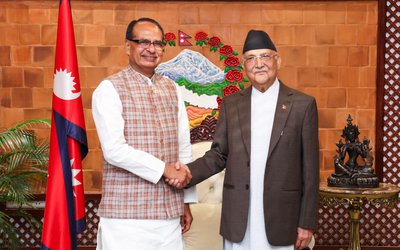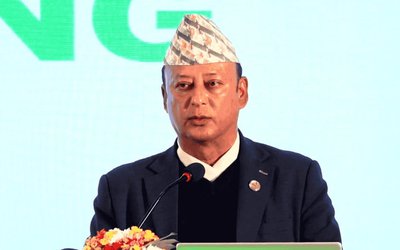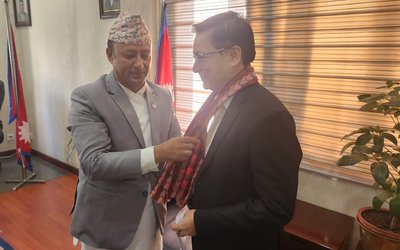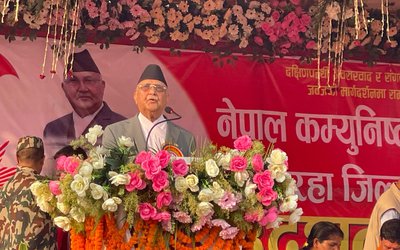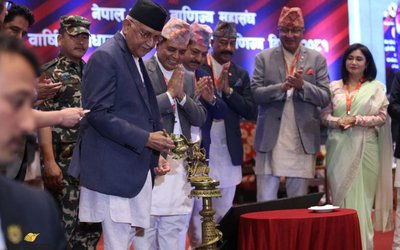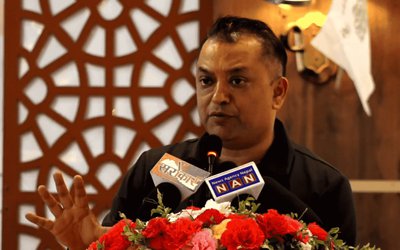
Unusual hailstorms have destroyed crops in the remote hill districts of Humla, Mugu and Kalikot. Similarly, hailstorms and rains destroyed paddy, which was at the last stage of harvesting, in Bardiya and Banke, the mid-western plains, in October.
For the last few years, Nepal has been recording unusual changes in temperature in its various parts, resulting in unpredictable weather patterns.
The Department of Hydrology and Meteorology recorded excessive rains in normally dry periods of time and there is less fog than there used to be. Along with these, the rise of temperature is threatening the glaciers in the Himalayas. Experts have predicted that Nepal’s glaciers will disappear if the trend of temperature rise continues.
In the long as well as short term, climate change will be affecting the livelihood of people. The victims of climate change are marginalized and poor families and communities of hills and plains of Nepal.
Extreme weather, including excessive rain, is inviting landslides upstream and floods in the plains in many river areas, making Nepal more vulnerable to natural hazards. According to available data, the days of rainfall are shortening but they are getting intense.
Sandwiched between India and China, two fastest growing economies of the world, Nepal will face more severe environmental consequences in the coming days as both of Nepal’s neighbors will burn more fossil fuels to accelerate their growth.
As Nepal is taking part in the United Nations Framework Convention on Climate Change-hosted twenty-first session of the Conference of Parties (COP21) in French capital Paris from November 30 to December 2015, there are opportunities as well as challenges for Nepal to share experiences and pains of being a small mountainous country and member of LDCs.
Experts argue that COP 21 is the most important juncture in the history of UNFCCC since its adaptation in 1992 where the parties need to deliver an international agreement to respond to the climate crisis.
Nepal’s Priority
This conference is important as a matter of life and death for LDCs and small mountainous countries like Nepal. If this conference fails to agree on new global deals, it will lead to catastrophic consequences. It will affect LDCs and mountainous countries like Nepal the most.
“Nepal has been actively taking part in COP as a party raising the voices of LDCs and mountainous countries. In COP 21, Nepal will continue to raise the issues of LDCs and small mountainous countries,” said Dr. K.C.Paudel, secretary of Ministry of Science, Technology and Environment (See Interview). “As one of the most vulnerable countries to the impacts of climate change, Nepal is taking various efforts to combat climate change through policy formulation and, institutional strengthening, program development and project implementation.”
Nepal formulated climate change policy 2011 and prepared National Adaptation Program of Action (NAPA) to support and help communities adapt to the immediate and urgent impacts of climate change. Nepal has also initiated the NAP process to address the medium and long term needs.
According to a report prepared by Ministry of Science, Technology and Environment on Key issues for Nepal COP 21/CMP11 UNFCCC Climate Change Conference, Nepal will stress the need to step up global action to cut greenhouse gas emissions before 2020 to address the gap between current emission pledges and the reductions needed to keep global warming below 2 degree Celsius or 1.5 degree Celsius, above pre-industrial level as acknowledge in Durban Climate Change Conference.
As workstream 2 (WS2), which reforest to actions before 2020 without legally binding targets, is vital for Nepal because if the biggest emitters keep on increasing their emission in the period of pre-2020, then the chances to limit temperature increase to 1.5 C will be difficult, which means Nepal’s average temperature rise will be higher than the global average.
As a member of LDCs, Nepal stands calling for an outcome with legal force to reinforce the need for a new legally binding instrument. Nepal stands strong for the legal form of the agreement. As a country vulnerable to climate change, it is crucial for Nepal to have more obligatory forms of agreement to ensure more trust and predictability.
In mitigation, Nepal advocates that peaking period should be before 2020 in the contest of the pre-2020 ambition and the post-2020 deal. Prepared by the experts for the MOSTE, the report highlights the areas for Nepal’s key issues.
As a member of LDCs, Nepal will again reiterate that developed nations have to take the lead on cutting GHG emissions as their historical responsibility.
Nepal’s Program
With the implementation of Nepal Climate Change Support Program (NCCSP), first of its kind, rural communities, with 55% women, are receiving access to climate resilient adaptation technology.
Initiated by MoSTE, Nepal Climate Change Support Program (NCCSP) is for access to knowledge on adapting to climate change, improving the resilience of vulnerable people through community involvement and to promote the results of the project as well as to receive technical solutions applicable to them.
The program ultimately helps meeting food and health needs and will support people’s ability to face climate change. And it will help them choose, consciously and individually.
Sometimes, investments in adaptation actually conflict with indigenous strategies to cope with climate hazards.
Lapses In Negotiations Team
Although Nepal has been participating in the COP over the last two decades, Nepal’s Foreign Ministry is yet to get involved in the process. Dominated by the experts and officials from MoSTE, Representatives from Ministry of Foreign Affairs are yet to get involved in the process fully.
COP is purely a political negotiation and all political leaders are coming to take part in COP. However, in Nepal, it is just under the purview of Ministry of Science, Technology and Environment. The part of negotiations should come under the Ministry of Foreign Affairs.
"When Chinese president, American president and Indian prime minister are taking part in COP in Paris, Nepal will also need to send its political leadership,” foreign secretary Shankardas Bairagi told New Spotlight.
According to MoSTE, a joint secretary from Ministry of Foreign Affairs will be included in Nepalese delegation this year.
Nepal’s Role in COP
Since the beginning, Nepal has been actively taking part in COP meetings. As a member of LDC group, Nepal has taken its stands based on the grouping's position. However, as a small mountainous country, Nepal also has its own mountain agenda, which it has been pushing for the last few years.
During 2013 and 2014, Nepal played a very active role to meet its own national interests and LDCs' interests. Nepal’s serious concerns understandably were to limit the global average of temperature rise. Despite contributing a negligible amount of green house gas emissions, Nepal is amongst the most vulnerable countries to the impacts of the climate change. The recent floods, droughts and hailstorms are just a few examples.
The threats of melting the snow in Himalayas have already alarmed Nepal. Studies of glaciers in Nepal have shown that many glaciers are retreating. If the temperature continues to rise at the present level, snow at Nepalese Himalayas might vanish.
As temperature is changing, Raute, nomadic people of Midwestern Nepal, are under threat. Living in Dailkeh, Kalikot and Accham districts, the Rautes, who are one of the most typical indigenous groups of Nepal, who have been sustaining their unique cultural identities for generations, are facing food crisis now.
Although there is so much link between climate change with livelihood and disasters, global climate change, development and disaster policy are yet to be integrated. But science says the problems, and ways to tackle them, are often interrelated.
Of course, climate change remains crucially important — ignoring it would miss an important dimension of disasters and development. But integrating efforts to adapt to it into disaster risk reduction work, and eventually including both within the broader development agenda, is imperative for achieving better-off and more resilient communities.
Global Agenda
This year three global policy processes will have set the stage for how the world responds to major challenges facing humanity in the years to come. A voluntary agreement to tackle disasters was reached in Sendai, Japan, in March. The voluntary Sustainable Development Goals (SDGs) were finalized in New York, United States, in September; and now, the world is moving towards the December climate change negotiations, aiming to agree an international treaty in Paris, France.
Science has long indicated that these three topics are connected. Separating them may be unnecessary and even counterproductive. Yet this policy separation is now more or less entrenched for the foreseeable future.
Even in Nepal, there are three different government institutions responsible for handling three issues. Ministry of Home Affairs claims to be the sole agency to handle disasters and MoSTE for climate change and National Planning Commission for SDG.
But this does not prevent using scientific evidence to identify actions common to all three. The idea of enfolding climate change within wider development topics has been present since climate change emerged as an important global concern.
Development Vs Climate Change
Scientists and politicians sometimes put forward climate change as the overarching or most important issue. They argue that the changes are so vast, swift and devastating that countries must focus resources and attention on them.
Climate change is indeed the main threat. But examining it in the wider context of development does not downplay its importance. Rather, it highlights how climate change connects with and influences other development concerns.
The suggestion that emissions of greenhouse gases influence the atmosphere, altering climate dates back to at least the nineteenth century.
What is Climate Change?
Human activities release carbon dioxide and other ‘greenhouse gases’ by burning coal, oil, and natural gas to generate electricity, using petrol to power vehicles and raising large herds of livestock. These gases accumulate and trap heat in the atmosphere, raising the planet’s average temperature and affecting the earth’s climate system.
Human-induced changes that reduce the planet’s ability to absorb these greenhouse gases reinforce their impact. For example, widespread deforestation means fewer trees to absorb carbon dioxide as they grow.
Oceans also absorb carbon dioxide, which reacts with water to make an acid. Ocean acidification is one of the impacts of climate change: more carbon dioxide in the air means more acidic oceans, potentially harming marine and coastal ecosystems.
According to scientific definition, given by the IPCC, climate change is a change in the properties or parameters of the earth’s climate, measured statistically and attributed to any source, natural or human. The policy definition, given by the UNFCCC, is the same but attributes it only to human activity.
Climate Change Impacts
Much literatures have already written on climate change. Climate change influences weather patterns and their extremes. Warmer air holds more water, making intense downpours more likely. This means that storms are likely to become more intense in many parts of the world due to climate change — but are also less frequent in some cases. This includes tropical cyclones.
Warmer climates will radically change ecosystems, possibly spreading human, animal and plant diseases into new locations. Changing rainfall will affect freshwater supplies, with some places receiving more and others less, in turn affecting food supplies. Some locations will gain substantially from improved agriculture while others could see local food sources being wiped out.
A weather-related event becomes a disaster when it harms people, property or social relationships, usually because political and development processes have not helped people reduce their vulnerability. Climate change itself cannot cause a disaster.
Despite there are connections, funders, institutions and governance structures frequently single out climate change and treat it independently. This is partly because of how the science and policy of climate change has evolved. Many scientists research only a particular dimension of climate change, and many treaty negotiators specialize in a single topic to ensure that agreements are detailed and robust.
The IPCC and UNFCCC processes have also separated climate change from other development topics. And they have separated climate change mitigation (cutting emissions or ‘capturing’ carbon) from adaptation (dealing with climate change impacts, which are part of disaster risk reduction).
Clear Overlaps
Despite the separation between the international policies for climate change, disaster risk reduction and development goals, science backs their full integration so they can complement and support each other.
One reason for this support is that dealing with climate change’s impacts is not really different from disaster risk reduction and sustainable development processes. In fact, all climate change adaptation sits within wider development objectives.
As Paris will play host to the 21st Conference of the Parties (COP21) to the UN Framework Convention on Climate Change (UNFCCC) — the event is likely to focus on long-term limits on emissions, not on adapting to change now, or on everyday development priorities. As Nepal has already made it clear that as a mountainous country its concern on the impacts of climate change in mountain country. Nepal can use COP 21 as a platform to create group for small mountainous country.

Keshab Poudel
Poudel is the editor of New Spotlight Magazine.
- PM OLI MEETS PM MODI: No Progress
- Apr 09, 2025
- PM OLI’S THAILAND VISIT: Flip Flop
- Apr 08, 2025
- FM Dr. Deuba’s India Visit: Mission Aborted
- Mar 26, 2025
- AMBASSADOR MAEDA TORU: Warm Regards
- Mar 24, 2025
- PRO-MONARCHY MOVEMENT: Rising Dissatisfaction
- Mar 23, 2025


